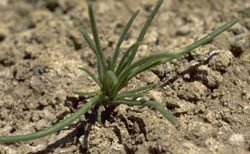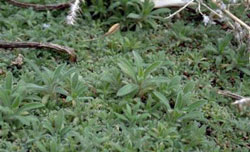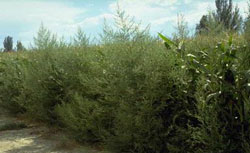by S. Bokan, K. Crumbaker, and G. Beck* (12/12)
Quick Facts…
- Read and comply with all herbicide labels, organic or nonorganic, for application rates, mixing instructions, protective equipment, re-entry period, grazing or harvest restrictions and other safety information.
- Kochia and Russian thistle, which are summer annuals, are troublesome annual weeds of rangelands, pastures, fields, disturbed areas, gardens, roadsides, ditchbanks, and small acreages. If uncontrolled, they become tumbleweeds that can disperse seeds over a large area.
- Nitrate, oxalate, sulfates, saponins, and alkaloids are found in kochia at levels that can cause poisoning in cattle and sheep. The likelihood of poisoning increases as the plant matures or when drought stressed.
- Russian thistle can accumulate toxic levels of nitrates which can cause acute respiratory difficulty and sudden death in cattle and sheep.
Weed Description

Figure 1. Russian thistle seedling. |
Kochia (Kochia scoparia L.) and Russian thistle (Salsola tragus L.) are troublesome annual weeds of rangelands, pastures, fields, disturbed areas, gardens, roadsides, ditchbanks, and small acreages. Both species are non-native to the United States. Kochia, a native of Asia, was introduced from Europe. Russian thistle originated in Russia and was brought to the U.S. in the late 1800’s as a contaminant of North Dakota flax seed. Kochia is found in all western states except Alaska. Russian thistle is found in every state in the U.S., except Alaska and Florida. Both plants reproduce only from seed; therefore preventing seed-set is important for successful management. Competition from desirable plant species will limit Russian thistle and kochia establishment and site dominance.

Figure 2. Kochia seedlings. |
Kochia is a summer annual plant, with many branches forming pyramidal or conical shaped bushes 6 ft. tall or greater. Leaves are small, fuzzy and gray-green in color. Leaves on older plants are alternate, linear shaped and 0.5 to 2 in. long and often hairy. The stems are highly branched and green or red tinged. When the seedlings germinate in the spring, infestations appear to be a graygreen mat. Kochia typically will germinate many times during the growing season, often beginning in March with last flushes occurring from August to early September. Flowers are inconspicuous. Seeds are dispersed when the plant matures and stems break off at the base; the plant then becomes a tumbleweed.

Figure 3. Mature kochia. |
Russian thistle, a large, bushy, prickly summer annual weed, can grow to 3 ft. tall. The stems are erect, many-branched and normally have red or purple striping. When
seedlings first emerge they look similar to grass seedlings. The leaves are alternate, small, narrow and appear scale-like with a stiff spine. The flowers, accompanied by a pair of spiny, floral bracts, are green and very inconspicuous. Russian thistle dries out and becomes a tumbleweed, spreading seeds as it rolls with the wind across landscapes.
Livestock Poisonings
Nitrate, oxalate, sulfates, saponins, and alkaloids are found in kochia at levels that can cause poisoning in cattle and sheep. While it can be used as forage in some areas, other forage species should also be available to avoid the possibility of livestock poisoning. The likelihood of poisoning increases as the plant matures or when drought stressed.
Russian thistle can accumulate toxic levels of nitrates which can cause acute respiratory difficulty and sudden death in cattle and sheep. Russian thistle contains oxalates, which may result in kidney failure in cattle and sheep if ingested.
Uses and Values
Kochia may provide good forage quality when the plant is young, however, the forage quality declines as the plant matures. The value to wildlife is shared by many species. Deer and pronghorn eat the foliage; seeds are consumed by songbirds and upland game birds. Kochia also provides loafing and nesting cover for upland game birds.
Russian thistle is fair forage when the plant is young. When the plant matures, it becomes unpalatable due to the spike-like inflorescence. When mature, Russian thistle provides excellent cover for pheasants, while small mammals and songbirds will feed on the seeds and foliage.
Integrated Weed Management Recommendation
The first step to controlling either of these plants is to keep current plants from producing seed that is added to the seed repository in soils. Limit disturbances such as tractor, animal and people traffic through infested areas to decrease its spread. Remove tumbleweeds from fence lines to keep plants from continuing to spread seed.
Kochia has a shallow taproot and can be easily pulled or hoed out at early growth stages. If it has already started producing seed, it is best to collect the plants and dispose of them, preventing further soil infestation. In fields, light tillage can disrupt the young plants from the soil. Mowing or cutting are limited options and must be timed to prevent the plant from regrowing and producing seed. Kochia will continue to produce seed on branches below mowing levels. Maintaining healthy pastures or fields will keep kochia from establishing.
Herbicides that will control kochia effectively include fluroxypyr (sold under the trade names of Vista and Starane), dicamba, and glyphosate. Fluroxypyr and dicamba are selective herbicides that will control broadleaf weeds and typically not injure grasses. 2,4-D, that is often applied for kochia control, is not effective. Glyphosate is a non-selective herbicide that injures or kills most vegetation contacted. Glyphosate is especially effective for controlling large kochia. Kochia biotypes resistant to glyphosate have been found, particularly in wheat-growing regions. Control from herbicides is best when applied when plants are small and in the 2-6 in. stage rather than on small fuzzy seedlings with little leaf surface area. Use of a non-ionic surfactant is recommended to allow the herbicide to penetrate the hairs and reach the leaf surface. Methylated seed oil at 1 to 2 qt/A is recommended when using fluroxypyr to control large kochia plants.
Organic herbicides, such as those containing acetic acid or clove oil, can be used to control kochia. These organic herbicides are contact materials and largely non-selective, but will not control perennials. They are corrosive to both skin and respiratory systems. Read the label before purchasing or using the product. Due to the hairs on the kochia leaves, the use of surfactants will aid organic herbicide absorption.
Russian thistle is easily pulled or hoed out, at early growth stages. If plants have already started producing seed, it is best to collect the plants and dispose of them to prevent new contributions to the soil seed reserve. Pulling the plants at later stages may require wearing gloves for comfort, due to the spike-like inflorescence. In fields, light tillage can disrupt the young plants from the soil. Mowing is a limited option that must be timed to prevent the plant from being able to regrow and produce seed, and is best done when the plant is beginning to bloom. Desirable plants may be damaged if mowing is too low. Maintaining healthy pastures or fields will prevent the establishment of Russian thistle.
Herbicides that will control Russian thistle include 2,4-D, dicamba, or glyphosate (sold under the trade name Roundup). Dicamba and 2,4-D are selective herbicides that will control many broadleaf weeds but usually do not injure grasses. Glyphosate is a non-selective herbicide that can injure or kill most vegetation contacted. Chemical control is best applied in the spring when plants are rapidly growing.
Organic chemicals can be used, such as those containing acetic acid or clove oil. These organic herbicides are contact materials and largely non-selective, but will not control perennials. They are also corrosive to skin and respiratory systems. Read the label before purchasing or using the product.
For best results on a stand where both species are present, use a mixture of dicamba plus 2,4-D, or dicamba plus fluroxypyr (Vista).
Read and comply with all herbicide labels, organic or nonorganic, for application rates, mixing instructions, protective equipment, re-entry period, grazing or harvest restrictions and other safety information.
Table 1. Herbicide Treatments
| Kochia | Dicamba: Banvel, Clarity, Vanquish 1-2 pt/A | Fluroxypr: Vista
1-2 pt/A; use higher rate for large plants |
|
| Russian thistle | Dicamba: Banvel, Clarity, Vanquish 1-2 pt/A | 2,4-D
1 qt/A |
Glyphosate: Roundup
1-1.5 qt/A |
References
Knight, Anthony P., Walter, Richard G., 1st Edition, 2001, A Guide to Plant Poisoning of Animals in North America.
Stubbendieck, James, Geir Friisoe, Margaret Bolick, 3rd Edition, 2003, Weeds of Nebraska and the Great Plains, Nebraska Department of Agriculture.
Whitson, Tom, Larry Burrill, Steven Dewey, David Cudney, B. Nelson, Richard Lee, Robert Parker, 9th Edition, 2006, Weeds of the West, the Western Society of Weed Science.
Colorado State Parks, Best Management Practice, Weed Profile, Russian thistle, https://cpw.state.co.us/Documents/ResourceStewardship/RussianThistle.pdf
Larimer County Weed District, 4th edition, Weed Management Reference Guide, https://www.larimer.org/sites/default/files/uploads/2017/webpresentation.pdf.
USDA NRCS, Plants Database, Plant Guide Kochia http://plants.usda.gov/plantguide/pdf/pg_basc5.pdf.
*S. Bokan, Colorado State University Extension, small acreage coordinator; K. Crumbaker, agent, agriculture and natural resources;G. Beck, Extension specialist, weed science, and professor; (12/12)
Colorado State University, U.S. Department of Agriculture, and Colorado counties cooperating. CSU Extension programs are available to all without discrimination. No endorsement of products mentioned is intended nor is criticism implied of products not mentioned.
Go to top of this page.





